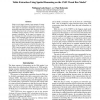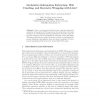171 search results - page 10 / 35 » Using Lexical Patterns for Extracting Hyponyms from the Web |
97
Voted
AAAI
2006
15 years 1 months ago
2006
Tables on web pages contain a huge amount of semantically explicit information, which makes them a worthwhile target for automatic information extraction and knowledge acquisition...
104
click to vote
LPNMR
2001
Springer
15 years 4 months ago
2001
Springer
Lixto is a system and method for the visual and interactive generation of wrappers for Web pages under the supervision of a human developer, for automatically extracting informatio...
113
Voted
WEBI
2010
Springer
14 years 9 months ago
2010
Springer
In this paper, we propose a Relation Expansion framework, which uses a few seed sentences marked up with two entities to expand a set of sentences containing target relations. Duri...
92
Voted
LREC
2010
15 years 1 months ago
2010
Resource-poor languages may suffer from a lack of any of the basic resources that are fundamental to computational linguistics, including an adequate digital lexicon. Given the re...
97
Voted
ECAI
2008
Springer
15 years 1 months ago
2008
Springer
Abstract. Measuring relational similarity between words is important in numerous natural language processing tasks such as solving analogy questions and classifying noun-modifier r...


